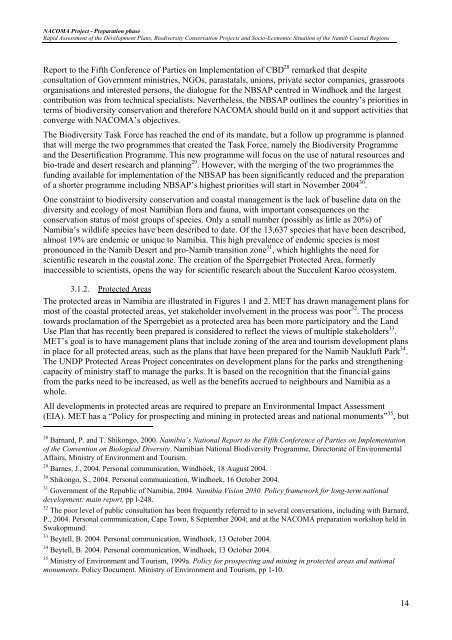Full report LR.pdf - DLIST Benguela
Full report LR.pdf - DLIST Benguela
Full report LR.pdf - DLIST Benguela
- No tags were found...
Create successful ePaper yourself
Turn your PDF publications into a flip-book with our unique Google optimized e-Paper software.
NACOMA Project - Preparation phaseRapid Assessment of the Development Plans, Biodiversity Conservation Projects and Socio-Economic Situation of the Namib Coastal RegionsReport to the Fifth Conference of Parties on Implementation of CBD 28 remarked that despiteconsultation of Government ministries, NGOs, parastatals, unions, private sector companies, grassrootsorganisations and interested persons, the dialogue for the NBSAP centred in Windhoek and the largestcontribution was from technical specialists. Nevertheless, the NBSAP outlines the country’s priorities interms of biodiversity conservation and therefore NACOMA should build on it and support activities thatconverge with NACOMA’s objectives.The Biodiversity Task Force has reached the end of its mandate, but a follow up programme is plannedthat will merge the two programmes that created the Task Force, namely the Biodiversity Programmeand the Desertification Programme. This new programme will focus on the use of natural resources andbio-trade and desert research and planning 29 . However, with the merging of the two programmes thefunding available for implementation of the NBSAP has been significantly reduced and the preparationof a shorter programme including NBSAP’s highest priorities will start in November 2004 30 .One constraint to biodiversity conservation and coastal management is the lack of baseline data on thediversity and ecology of most Namibian flora and fauna, with important consequences on theconservation status of most groups of species. Only a small number (possibly as little as 20%) ofNamibia’s wildlife species have been described to date. Of the 13,637 species that have been described,almost 19% are endemic or unique to Namibia. This high prevalence of endemic species is mostpronounced in the Namib Desert and pro-Namib transition zone 31 , which highlights the need forscientific research in the coastal zone. The creation of the Sperrgebiet Protected Area, formerlyinaccessible to scientists, opens the way for scientific research about the Succulent Karoo ecosystem.3.1.2. Protected AreasThe protected areas in Namibia are illustrated in Figures 1 and 2. MET has drawn management plans formost of the coastal protected areas, yet stakeholder involvement in the process was poor 32 . The processtowards proclamation of the Sperrgebiet as a protected area has been more participatory and the LandUse Plan that has recently been prepared is considered to reflect the views of multiple stakeholders 33 .MET’s goal is to have management plans that include zoning of the area and tourism development plansin place for all protected areas, such as the plans that have been prepared for the Namib Naukluft Park 34 .The UNDP Protected Areas Project concentrates on development plans for the parks and strengtheningcapacity of ministry staff to manage the parks. It is based on the recognition that the financial gainsfrom the parks need to be increased, as well as the benefits accrued to neighbours and Namibia as awhole.All developments in protected areas are required to prepare an Environmental Impact Assessment(EIA). MET has a “Policy for prospecting and mining in protected areas and national monuments” 35 , but28 Barnard, P. and T. Shikongo, 2000. Namibia’s National Report to the Fifth Conference of Parties on Implementationof the Convention on Biological Diversity. Namibian National Biodiversity Programme, Directorate of EnvironmentalAffairs, Ministry of Environment and Tourism.29 Barnes, J., 2004. Personal communication, Windhoek, 18 August 2004.30 Shikongo, S., 2004. Personal communication, Windhoek, 16 October 2004.31 Government of the Republic of Namibia, 2004. Namibia Vision 2030. Policy framework for long-term nationaldevelopment: main <strong>report</strong>, pp l-248.32 The poor level of public consultation has been frequently referred to in several conversations, including with Barnard,P., 2004. Personal communication, Cape Town, 8 September 2004; and at the NACOMA preparation workshop held inSwakopmund.33 Beytell, B. 2004. Personal communication, Windhoek, 13 October 2004.34 Beytell, B. 2004. Personal communication, Windhoek, 13 October 2004.35 Ministry of Environment and Tourism, 1999a. Policy for prospecting and mining in protected areas and nationalmonuments. Policy Document. Ministry of Environment and Tourism, pp 1-10.14












